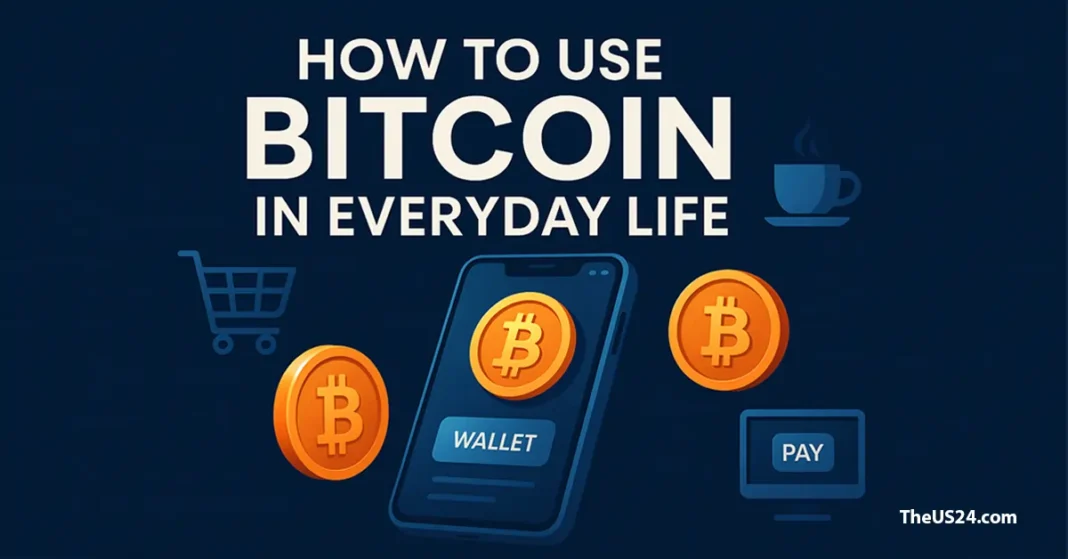Can you really use Bitcoin (BTC) for everyday purchases in the USA, like buying coffee or paying bills? In 2025, Bitcoin is no longer just a speculative investment—it’s becoming a practical tool for daily life. From online shopping to in-store payments, using Bitcoin in everyday life is easier than ever. This guide explores how to spend Bitcoin in the USA, covering platforms, security tips, and tax considerations. With a real-life example of a Bitcoin user, we’ll show you how to integrate BTC into your routine while aiming for financial freedom. Ready to make Bitcoin work for you? Let’s dive in!
Why Use Bitcoin in Everyday Life?
Bitcoin, launched in 2009, is a decentralized digital currency built on a secure blockchain. Unlike traditional money, it operates without banks, offering low fees and global reach. In 2025, Bitcoin’s price hovers around $80,000, but you don’t need to buy a whole coin—fractions (satoshis) make it accessible for small transactions. In the USA, Bitcoin adoption is growing, with businesses accepting it directly or through payment processors.
Also read: Top 10 Best Credit Cards in the U.S for 2025: Rewards, Cashback, and More
6 Ways to Use Bitcoin in Everyday Life
1. Shop Online with Bitcoin
Many online retailers in the USA accept Bitcoin, making it easy to buy products or services.
- How It Works: Use Bitcoin to pay at checkout via payment processors like BitPay or CoinPayments.
- Examples: Purchase electronics, clothing, or gift cards from major online stores.
- Why It Matters: Bitcoin offers fast, low-fee transactions for online shopping.
- Action: Check retailer websites for a Bitcoin payment option or BitPay logo.
2. Pay In-Store with Crypto Debit Cards
Crypto debit cards let you spend Bitcoin at physical stores by converting it to USD instantly.
- How It Works: Load a card with Bitcoin from your wallet. Use it like a regular debit card at stores, restaurants, or gas stations.
- Examples: Cards from trusted providers support Visa or Mastercard networks, accepted at millions of locations.
- Why It Matters: Seamlessly integrate Bitcoin into daily purchases without manual conversions.
- Action: Sign up for a crypto debit card and link it to your Bitcoin wallet.
3. Buy Gift Cards with Bitcoin
Gift cards are a versatile way to use Bitcoin at stores that don’t accept it directly.
- How It Works: Purchase gift cards for popular retailers or services using Bitcoin on platforms designed for crypto transactions.
- Examples: Buy cards for Amazon, Starbucks, or Walmart to cover everyday expenses.
- Why It Matters: Expands Bitcoin’s usability to non-crypto-friendly businesses.
- Action: Visit a crypto gift card marketplace and select cards for your favorite stores.
4. Pay Bills or Subscriptions
Some utility providers and subscription services in the USA accept Bitcoin for payments.
- How It Works: Use payment processors to settle bills (e.g., internet, phone) or subscriptions (e.g., streaming services) with Bitcoin.
- Examples: Certain platforms allow Bitcoin payments for utilities or digital services.
- Why It Matters: Simplifies recurring payments with a single currency.
- Action: Check with your service providers or use a crypto payment platform to pay bills.
5. Send Money to Friends or Family
Bitcoin enables fast, low-cost peer-to-peer transfers, ideal for splitting bills or sending gifts.
- How It Works: Send Bitcoin to someone’s wallet address using a mobile app or exchange. Transactions confirm in minutes.
- Examples: Pay a friend for dinner or send money to family across the USA.
- Why It Matters: Cheaper and faster than bank wires or payment apps for small amounts.
- Action: Download a Bitcoin wallet app and practice sending small amounts.
6. Travel with Bitcoin
Bitcoin is gaining traction in the travel industry, letting you book flights, hotels, or experiences.
- How It Works: Use travel agencies or booking platforms that accept Bitcoin for reservations.
- Examples: Pay for hotel stays, car rentals, or vacation packages with BTC.
- Why It Matters: Offers flexibility for travelers, especially internationally.
- Action: Explore crypto-friendly travel sites for your next trip.
Real-Life Example: How Lisa Uses Bitcoin Daily
Meet Lisa, a 29-year-old graphic designer from New York. In 2023, Lisa started using Bitcoin for everyday expenses, intrigued by its convenience and low fees. She invested $2,000 in BTC at $30,000 per coin and began integrating it into her routine. Here’s how Lisa uses Bitcoin in 2025:
- Online Shopping: Lisa buys art supplies online, paying with Bitcoin through a payment processor. She saved 5% on fees compared to credit cards.
- Crypto Debit Card: She loaded a crypto debit card with 0.01 BTC ($800) and uses it for groceries, coffee, and dining, spending seamlessly at local stores.
- Gift Cards: Lisa purchased a $100 Amazon gift card with Bitcoin to buy books, extending BTC’s reach to non-crypto retailers.
- Bill Payments: She pays her internet bill using a crypto payment platform, streamlining her monthly expenses.
Lisa’s Strategy:
- Wallet Security: Lisa uses a hardware wallet for long-term storage and a mobile wallet for daily transactions.
- Tax Tracking: She logs transactions for IRS capital gains tax, as selling or spending BTC triggers taxable events.
- Small Transactions: Lisa spends fractions of BTC (e.g., 0.0001 BTC for a $8 coffee) to avoid volatility risks.
Outcome: By 2025, Lisa’s remaining Bitcoin grew to $4,800 (at $80,000/BTC), and she saved $150/year on fees. Her lesson? Bitcoin is practical for daily life with proper security and planning.
Takeaway: Lisa’s experience shows how Bitcoin can replace cash or cards for everyday needs, offering convenience and savings. Consult a financial advisor to adapt her approach.
Security Tips for Using Bitcoin Safely
Using Bitcoin requires vigilance to protect your funds. Follow these tips:
- Use a Secure Wallet: Store most of your Bitcoin in a hardware wallet (offline) and a small amount in a mobile wallet for spending.
- Enable Two-Factor Authentication (2FA): Secure your exchange or wallet app with 2FA to prevent hacks.
- Verify Addresses: Double-check wallet addresses before sending Bitcoin to avoid scams.
- Avoid Public Wi-Fi: Don’t access wallets on unsecured networks to prevent data theft.
- Backup Your Wallet: Save your private keys or seed phrase in a safe place (e.g., a fireproof safe).
Why It Matters: Security ensures your Bitcoin is safe for daily use, protecting your financial freedom.
Tax Considerations for Spending Bitcoin in the USA
In the USA, Bitcoin is treated as property for tax purposes, meaning spending or selling it triggers capital gains tax.
- How It Works: Calculate the difference between the price you paid for Bitcoin and its value when spent.
- Example: If you bought 0.01 BTC at $50,000 ($500) and spent it at $80,000 ($800), you owe tax on the $300 gain.
- Short-Term vs. Long-Term: Gains held under a year are taxed at your income rate; over a year, at lower capital gains rates.
- Tracking: Use apps to log transactions for accurate tax reporting.
- Action: Keep records of every Bitcoin transaction and consult a tax professional for IRS compliance.
Why It Matters: Understanding taxes prevents surprises and keeps your Bitcoin use legal.
Step-by-Step Guide to Start Using Bitcoin
Ready to spend Bitcoin? Follow these steps for USA users:
- Set Up a Wallet: Download a mobile wallet for daily use or buy a hardware wallet for security.
- Buy Bitcoin: Purchase BTC on a trusted exchange, starting with $50–$100.
- Choose a Payment Method: Get a crypto debit card, use a payment processor, or buy gift cards.
- Secure Your Funds: Enable 2FA, back up your wallet, and store private keys safely.
- Start Spending: Pay online, in-store, or for bills using Bitcoin-friendly platforms.
- Track Taxes: Log transactions for tax reporting, using software if needed.
FAQs About Using Bitcoin in Everyday Life
Can I use Bitcoin for daily purchases in the USA?
Yes, many online and physical stores accept Bitcoin directly or via crypto debit cards.
What’s the easiest way to spend Bitcoin?
Crypto debit cards convert Bitcoin to USD instantly, making in-store purchases simple.
Are there fees for using Bitcoin?
Bitcoin transactions have low fees (often under $1), but payment processors may charge small percentages.
Is it safe to use Bitcoin for everyday transactions?
Yes, with secure wallets and 2FA, but verify addresses and avoid public Wi-Fi.
Do I pay taxes when spending Bitcoin?
Yes, spending Bitcoin triggers capital gains tax on any price increase since purchase.
Conclusion: Make Bitcoin Part of Your Daily Life
Using Bitcoin in everyday life in the USA is practical and accessible in 2025, from shopping online to paying bills. Lisa’s real-life example shows how crypto debit cards, gift cards, and secure wallets make Bitcoin a versatile tool. With low fees, global reach, and growing adoption, Bitcoin offers a path to financial freedom while complementing traditional money.
Ready to start? Set up a wallet, buy $50 of Bitcoin, and try a crypto debit card for your next coffee. Stay secure, track taxes, and consult a financial advisor to maximize Bitcoin’s benefits. Embrace Bitcoin today and simplify your daily transactions!

